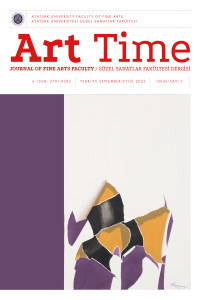Türkiye’de Günümüzde Üretilen Keçe Tasarımları
Felt Desıgns Produced in Turkey Today
Felt is a textile material obtained from the mixing of wool fibers, which are animal fibers, with heat,
soap and water. There are written sources that state that the Turks, who first settled in the Huns period, used
felt. According to these sources, felt was used not only outside the tents but also in the upholstery inside the
tent. It has changed in the design of the products obtained with the art of felt, which has survived until today.
Previously, products such as floor mats, tent covers, shutters, aba and coins were produced, but different design
products were produced over time. These new designs include portraits, scarves, rugs, paintings and different
clothing samples. Design is the process of making the product one wants to produce from abstract to concrete.
The person is mostly original when designing and thinking about the technique and material of the work he
wants to produce. Designs can be aesthetic and relative, as well as change over time. Design is variable
according to developing technology, time and person. It is unique because it is obtained after the imagination
of the creator. With the research done, different felt designs obtained today are discussed and information is
given about the techniques used in obtaining the designs.
___
- Ergenekon, C. (1994). Tepme keçelerin tarihi gelişimi ile renk desen teknik ve kullanım özellikleri. Gazi Üniversitesi, Sosyal Bilimler Enstitüsü, El Sanatları Eğitim Anabilim Dalı, Doktora Tezi.
- Küçükkurt Ü. and Oyman N. R. (2018). Afyonkarahisar’da keçe üretimi ve keçe atölyeleri. Kültür ve Sosyal İşler Müdürlüğü Kültür Yayınları. Yayın: 59.
- Aslanapa, O. (1972). Türk Sanatı I. Milli Eğitim Basımevi.
- Sultanbekova, K. (2015). Süleyman Demirel Üniversitesi GSF. Grafik bölümü Yüksek Lisans öğrencisi. Röportaj, Akt: Derabaşo, Zuhal.
- Kılıç Karatay, S. (2019). Yalvaç keçe sanatının günümüzdeki durumu. Atatürk Güzel Sanatlar Fakültesi Sanat Dergisi, Sayı:34, 167-173.
- Başlangıç: 2021
- Yayıncı: Atatürk Üniversitesi
